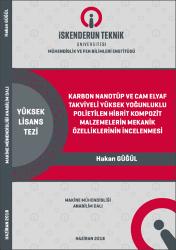| dc.contributor.advisor | Yapıcı, Ahmet | |
| dc.contributor.author | Güğül, Hakan | |
| dc.date.accessioned | 2019-07-12T11:41:18Z | |
| dc.date.available | 2019-07-12T11:41:18Z | |
| dc.date.issued | 2018 | en_US |
| dc.date.submitted | 2018 | |
| dc.identifier.citation | Gugul, H. (2018). Karbon nanotüp ve cam elyaf takviyeli yüksek yoğunluklu polietilen hibrit kompozit malzemelerin mekanik özelliklerinin incelenmesi (Yüksek Lisans Tezi). İskenderun Teknik Üniversitesi / Mühendislik ve Fen Bilimleri Enstitüsü, Hatay. | en_US |
| dc.identifier.uri | https://hdl.handle.net/20.500.12508/434 | |
| dc.description.abstract | Ülkemizde ve dünyada son yıllarda kompozit malzemelerin gelişmesiyle birlikte karbon nanotüp (KNT) üzerinde araştırmalar ve sentezlenme işlemleri yaygınlaşmıştır. Karbon nanotüp, çok hafiftir ve yüksek dayanıma sahiptir. Cam elyaf ise yüksek çekme ve aşınma dayanımına sahip olması sebebiyle plastik esaslı malzemelerde güçlendirici olarak kullanılmaktadır. Bu çalışmada yüksek yoğunluklu polietilen (YYPE) ile ağırlıkça %0,5; %1 ve %1,5 oranlarında KNT, aseton ile karıştırılmıştır. Ultrasonik karıştırıcı ve manyetik karıştırıcıda karıştırıldıktan sonra aseton buharlaştırılmıştır. YYPE ve KNT karışımı, çift vidalı ekstruderden geçirilerek tamamen homojen hale gelmiştir. Granül haldeki bu malzemeye cam elyaf takviyesi yapılarak sıcak pres makinası yardımıyla kompozit plakalar üretilmiştir. Plakalar lazer kesim cihazında kesilerek deney numuneleri elde edilmiş ve numunelerin testleri yapılarak mekanik özellikleri incelenmiştir. Yapılan deneyler sonucunda, cam elyaf ve tüm oranlarda yapılan KNT takviyesinin mukavemet değerlerini arttırdığı görülmüştür. Bu takviyelerle malzemede iyi bir dayanım artışı sağlanmıştır. | en_US |
| dc.description.abstract | In recent years, research and synthesis processes on carbon nanotubes (CNTs) have become widespread with the development of composite materials in our country and the world. CNTs are so lightweight and high strength material. Because of high tensile strength and abrasion resistance of glass fiber, is used as a strengthening in plastic-based materials. In this work, high density polyethylene (HDPE) and 0,5; 1 and 1,5% by weight of CNTs were mixed with acetone. The acetone was evaporated after mixing in the ultrasonic mixer and magnetic stirrer. Mixtures of HDPE and CNTs have become completely homogeneous by passing it through a twin-screw extruder. The composite plates made from glass fiber, HDPE and CNTs by hot press machine. Plates were cut by laser cutting machine, so test samples were obtained. This samples were tested and then their mechanical properties have been examined. The result of the experiments showed that reinforcement of glass fiber and all proportions of CNTs increased strength values. With these reinforcements, provided a good strength increase on the material. | en_US |
| dc.language.iso | tur | en_US |
| dc.publisher | İskenderun Teknik Üniversitesi / Mühendislik ve Fen Bilimleri Enstitüsü / Makine Mühendisliği Anabilim Dalı | en_US |
| dc.rights | info:eu-repo/semantics/openAccess | en_US |
| dc.subject | Kompozit | en_US |
| dc.subject | Karbon nanotüp | en_US |
| dc.subject | Cam elyaf | en_US |
| dc.subject | Yüksek yoğunluklu polietilen | en_US |
| dc.subject | Composite | en_US |
| dc.subject | Carbon nanotubes | en_US |
| dc.subject | Glass fiber | en_US |
| dc.subject | High density polyethylene | en_US |
| dc.title | Karbon nanotüp ve cam elyaf takviyeli yüksek yoğunluklu polietilen hibrit kompozit malzemelerin mekanik özelliklerinin incelenmesi | en_US |
| dc.title.alternative | Investigation of the mechanical properties of carbon nanotubes and glass fiber reinforced high density polyethylene hybrid composite materials | en_US |
| dc.type | masterThesis | en_US |
| dc.contributor.department | Mühendislik ve Fen Bilimleri Enstitüsü | en_US |
| dc.relation.publicationcategory | Tez | en_US |
| dc.contributor.isteauthor | Yapıcı, Ahmet | |
| dc.relation.index | İndeks Bilgisi Yok | en_US |
















